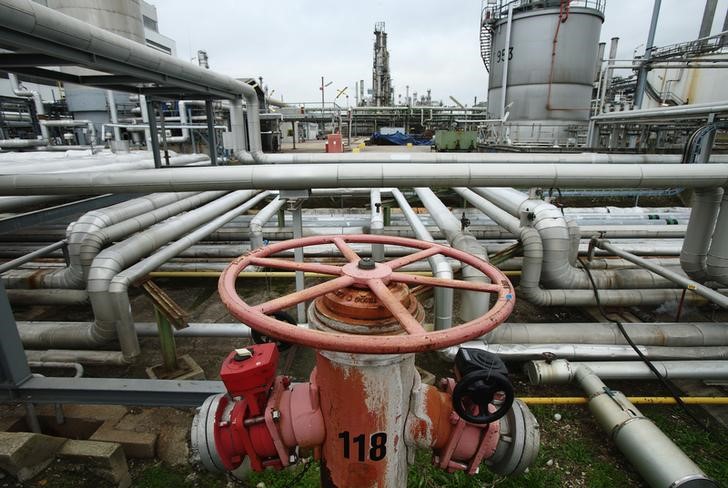(The opinions expressed here are those of the author, a columnist for Reuters.)
* OPEC, non-OPEC crude oil supply - http://tmsnrt.rs/2gnobWD
By Clyde Russell
LAUNCESTON, Australia, Dec 12 (Reuters) - The global crude oil market is starting to resemble a gigantic game of chess, with a bold opening gambit by OPEC and its allies giving them an advantage, but the game is still far from checkmate.
The weekend deal by 12 countries outside OPEC to join the producer group's agreement to curb crude output certainly looks bullish for prices, as it takes the total amount of oil leaving the market in the first half of 2017 to almost 1.8 million barrels per day (bpd). crude LCOc1 , the global benchmark, reacted strongly in early trade in Asia on Monday, gaining as much as 6.6 percent from the close on Dec. 9 to as much as $57.89 a barrel.
Brent has gained nearly 40 percent since its early August low of just above $41 a barrel, and has been rising as OPEC first talked about, and then delivered, curbs to production.
The first OPEC and non-OPEC deal since 2001 will see Russia, the world's top producer, shouldering most of the non-OPEC cuts, with a commitment to reduce output by 300,000 bpd over the first half of next year.
Other non-OPEC producers such as Mexico, Brunei, Malaysia, Kazakhstan, Oman and South Sudan will chip in another 280,000 bpd of cuts, according to the agreement reached in Vienna on Dec. 10.
This will add to the 1.2 million bpd of reductions agreed to by the 13-member OPEC at their meeting on Nov. 30.
So far it all looks very positive for the oil producers. They have achieved a broad-based agreement that promises to cut output by about 2 percent of the world's daily crude consumption, which is certainly significant.
They have managed to overcome political tensions and even hostilities, such as the rivalry between Saudi Arabia and Iran, with both countries backing different sides in various conflicts around the Middle East.
And OPEC has also been successful in convincing other producers to join in the cuts. Taken together, the OPEC and allied non-OPEC producers account for close to 60 percent of global crude output.
So, what can go wrong?
CHEATING, SHALE
In a nutshell, there are two major things that could undermine the success of the OPEC, non-OPEC agreement.
The first is compliance. Former Saudi oil minister Ali al-Naimi hit the nail on the head after an address in Washington on Dec. 2. "Unfortunately, we tend to cheat," the industry veteran said of the OPEC deal.
Certainly, for the deal to work, much will depend on the actions of Saudi Arabia and Russia, as they account for almost half of the planned combined output cuts.
The Saudis have indicated that they intend to reduce the amount of crude supplied to customers from January, Reuters reported on Dec. 9, citing an industry source familiar with Saudi policy. in the United States and Europe will face bigger cuts than those in Asia, ostensibly because of the large inventories in the United States.
But it may also be the case that the Saudis want to protect their market share in Asia, the destination of about two-thirds of their oil exports.
The kingdom has been locked in an intense battle with Russia, Iran and Iraq this year in supplying crude to the region's top two buyers, China and India.
While the Saudis have increased overall volumes, they haven't done so by as much as their competitors, meaning they have lost market share and so far this year Russia has usurped their position as the top supplier to China.
Iraq will supply full contracted volumes of crude to three Asian buyers in January, Reuters reported on Dec. 9, citing three sources with knowledge of the matter. Iran cut its official selling price of its light crude grade for Asian customers to the lowest in four months for January cargoes, although it did raise it for other regions. with Russian Energy Minister Alexander Novak's statement that his country's cuts next year will be gradual, it's possible that Asian oil markets will remain quite well supplied in the early months of 2017.
It will take some time to work out the level of compliance with the agreed output cuts, and if there is cheating, the question then becomes whether the Saudis will tolerate this, assuming they are not one of those cheating as well.
The other risk to the deal is the response of the 40 percent of world oil output not subject to the agreement, with the key swing producers being U.S. shale drillers.
An oil price of close to $60 a barrel brings them back into play, as can be seen by the rising drilling rig count in the United States, now in its seventh month of expansion. lifting of the ban on crude exports from the United States has also opened the way for increased output to make its way to Asian refiners, something that already appears to be happening.
Oil major BP BP.L is shipping almost 3 million barrels of U.S. crude to Asia, Reuters reported on Dec. 7. Other traders are also showing interest in developing new routes, moves that may undermine the efficacy of the OPEC/non-OPEC deal.
It's doubtful that U.S. shale output can rise enough to offset the whole 1.8 million bpd cuts announced by OPEC and its allies, but other producers may also be able to take advantage of rising prices, such as Canada, Brazil and Norway.
Where the oil price ultimately heads in the first half of next year will be decided by whether the actions of OPEC and its allies match their words, and how can the other producers counter-punch.
<^^^^^^^^^^^^^^^^^^^^^^^^^^^^^^^^^^^^^^^^^^^^^^^^^^^^^^^^^^^ OPEC and non-OPEC crude oil supply
http://tmsnrt.rs/2gnobWD
^^^^^^^^^^^^^^^^^^^^^^^^^^^^^^^^^^^^^^^^^^^^^^^^^^^^^^^^^^^> (Editing by Richard Pullin)
